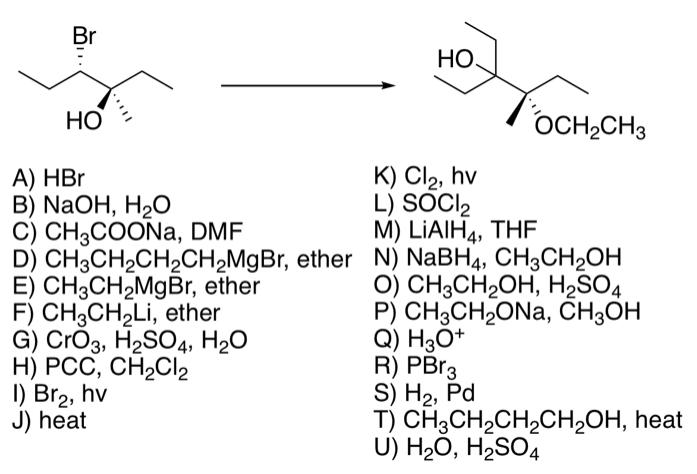Answered step by step
Verified Expert Solution
Question
1 Approved Answer
Look at the given synthesis and the provided reagents. Fill in the blanks with the single letter codeof the appropriate reagent, or the appropriate



Look at the given synthesis and the provided reagents. Fill in the blanks with the single letter codeof the appropriate reagent, or the appropriate descriptive vocabulary word/phrase for non-reagents to complete the synthesis and description. spelling. carefully! Br HO A) HBr B) NaOH, HO C) CH3COONa, DMF HO K) Cl, hv L) SOCI 2 M) LIAIH, THF OCH2CH3 D) CH3CH2CH2CH2MgBr, ether N) NaBH4, CH3CH2OH E) CH3CH2MgBr, ether F) CH3CH2Li, ether G) CrO3, H2SO4, HO H) PCC, CH2Cl2 I) Br, hv J) heat O) CH3CH2OH, H2SO4 P) CH3CH2ONA, CH3OH Q) H3O+ R) PB3 S) H2, Pd T) CH3CH2CH2CH2OH, heat U) HO, H2SO4 -First we add a(n) base (please help here) (oxidizing agent, reducing agent, acid, base, electrophile, nucleophile) in the form of reagent B, which will create the functional group alkoxide ion. -This ion immediately undergoes a addition/elimination mechanisms in a epoxide synthesis to form the functional group epoxide. -Then addition of reagent P will create two functional groups: -a tertiary ether -and a secondary alcohol. -Then addition of reagent PCC will form a ketone functional group, which will give the final product upon addition of reagent (please help here) and reagent (please help here) workup.
Step by Step Solution
There are 3 Steps involved in it
Step: 1

Get Instant Access to Expert-Tailored Solutions
See step-by-step solutions with expert insights and AI powered tools for academic success
Step: 2

Step: 3

Ace Your Homework with AI
Get the answers you need in no time with our AI-driven, step-by-step assistance
Get Started


